Tomie dePaola

Since Tomie dePaola illustrated his first children’s book in 1965, he has authored and illustrated some 225 books including the 1976 Caldecott Honor book “Strega Nona.” Many of these are featured in a career-survey exhibition, “Drawings from the Heart: Tomie dePaola Turns 75,” at the Eric Carle Museum of Picture Book Art in Amherst, Massachusetts, through Nov. 1. I recently telephoned dePaola (above) at his home in New London, New Hampshire, where he was recuperating from carpal tunnel surgery on his drawing hand and various other ailments that forced him to very reluctantly cancel his fall book tour. We spoke about his process; about his fascination with folk tales and legends of Europe, Mexico, Native America, and the Catholic church; about his faith; about what it’s like to be a gay children’s book author and illustrator; and about his love of New England. Below are some excerpts.
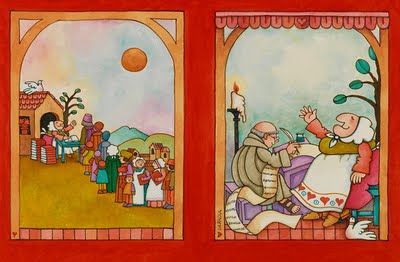
“In those early days, picture books, we weren’t able to use full colors. It was just too expensive. So the books were printed in what was called pre-separation. It would be a black base plate and then overlays. The color would be chosen in either line application or half-tone application. If you were lucky you got three colors. The average was two colors – black and one color. On many of the books, there was black and white on one page and on the following page black and the color. So I was getting messages from little kids saying, ‘You forgot to color in the whole book.’”
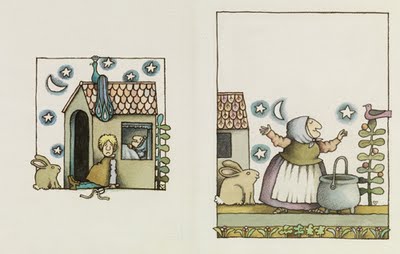
“I use acrylic. Years ago I was doing watercolor. I don’t think I’ve done anything in watercolor since after the first ‘Strega Nona’ [1975, pictured above]. Because ‘Clown of God’ [1978, pictured below] is in acrylic. They developed an acrylic that was strong enough that you didn’t have to put it on thickly. You could water it way down and it would still hold its integrity. And it was light fast. That became very important because back in the ‘70s there was a beginning of the growing market– which is still growing – of original children’s book illustration as art. And people buying it as art. Like the Michelson Gallery in Northampton, and the Cove Gallery in Wellfleet and certain other galleries across the country that actually sell original children’s book illustration. So that’s when I switched to acrylic … On top of that I do paintings and drawings that are non-books. A lot of people don’t even know I do that except the people who go to see my gallery shows at various places. I’ve always shown in art galleries as well as through the book publications.”
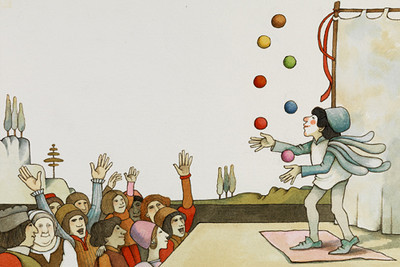
“I don’t have any secrets of working. I get an idea. I discuss the idea with my editor. It goes around and around. Then I sit down and write the text. Sometimes the text comes very easy. And sometimes it’s a real struggle. There are different kinds of texts that just are cranky and others that just flow out onto paper. And then always the editorial process, which is a very interesting process for me, discussing it with the various editors that I work with. In the meantime, we kind of are settled on the size. That, of course, is all agreed upon by sales and marketing these days. And bookstores, because bookstores don’t like books that are too big, that they can’t shelve. So there are sort of standard sizes. And I discuss that with my art director. Then I start to fool around and see how I want to express the art in this particular book coming up and what technique I’m going to use and what materials I’m going to use. Quite often, if the book is one of my autobiographical picture books or a ‘Strega Nona’ the style is pretty well set. The ‘Strega Nona’ books all look alike, and they should. The same with the books about myself as a little kid. Then I have a chance to branch off into things like ‘Adelita’ [2002, pictured below], the Mexican Cinderella story that I created. Then I branched out recently into some little forays into collage. There’s a book called ‘Song of Francis’ [2009] and I did that all in collage.”
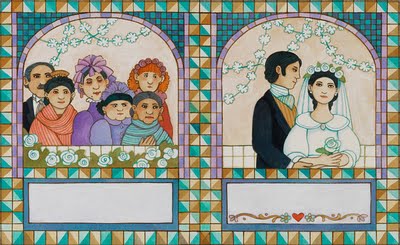
“Years ago the great artist Ben Shahn, I heard him give a lecture called ‘The Shape of Content.’ He strongly felt that the old masters and the pre-Medieval painters, like Giotto and Fra Angelico, their shapes and their style were really in sync with the content of their images. Fra Angelico used the Romanesque rounded arch over and over again to set up a rhythm of calmness. And he only painted calm scenes. There’s very few Fra Angelico crucifixions. They’re mostly annunciation or birth of Christ, etcetera. For me that’s part of my personal training. … Certainly if I’m going to do a New England group of folk tales or folk sayings I’m going to make the landscape and people look as New Englandy as possible, and the same with Mexican or Italian.”
“I hate to do sketches. So I go from little tiny thumbnails on toilet paper to pencil drawing on my expensive watercolor paper and go right to finishes. I give them the option, I say, ‘I’ll do it over if you insist.’ But, of course, they don’t ask me to do it over very much. Every once in a while. Not too often. I found out there’s some people that thrive on doing these elaborate sketches, layered sketches. I find that my art dies. I lose the spontaneity of the spirit of my hand, my signature, my calligraphic line.”
“I think one of the most important things for the visual artist is to have self-criticism. Most artists I know know when they do something really lousy. And if they don’t know they’ve done something lousy the kids will tell them. They’re not shy about it at all.”
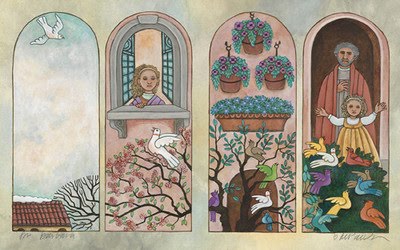
In the 1950s, you considered becoming a monk? “Yes, at the Benedictine community and Western Priory in Weston, Vermont. The monastery is still there. There’s 12 men. They’re very good friends of mine. As well as the Benedictine nuns at Regina Laudis Abbey in Bethlehem, Connecticut. I think it was more that there were other things for me to do with my life, and one of them was to really and truly be a full-fledged artist. If you’re a monk artist, you’re really divided in your priorities. But I’ll never regret any of the minutes I spent in the monastery, or my wanting to explore it, because it certainly added to my own personal spiritual life. I consider myself a good Benedictine in my soul. As I say, I’m still very friendly with the Benedictines. I was only there about six months the first time. I tried three times – 1956, 1966 and then a very brief couple weekends in ’70, ’71. I gave it the good old school try.”
On Sister Corita Kent: “We showed at the same gallery [Botolph Gallery in Boston]. We became friends. We were kind of in the same Catholic liberal [group]. This was during the Vietnam War, and there was a whole group of us, and a lot of contemporary liturgical artists. From the time I was in art school I was always interested in contemporary liturgical art, because I always thought the art of the contemporary Catholic church was horrible, sentimental. And when you compared it with the beautiful pre-Renaissance, the beautiful Gothic cathedrals and the Romanesque carvings, spirituality had gone out of the buildings and the artwork. I’m talking about the kind of church I went to as a child. It was all the glass-eyed statues and all this over-decorated stuff and these sappy stained glass windows. You go compare a window at Chartres or Notre Dame de Paris to Boston Cathedral, one is schlock and one is art. That is not to say there aren’t some beautiful contemporary [churches]. In fact if you want to see some incredible contemporary stained glass windows go to St. John’s Abbey in Collegeville, Minnesota. Their abbey church was built by Marcel Breuer. And several of his friends, including Josef Albers, did the windows.”
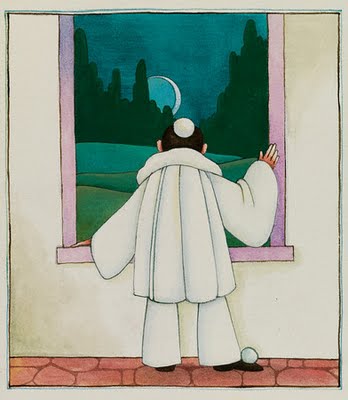
“That was a very interesting time to be a liberal Catholic. The Berrigan brothers were alive and well. I was teaching at Newton College of the Sacred Heart at that time, the early ‘60s. I was actually teaching in the Boston area and living in New York. So I was commuting. It was a quite interesting time because of the Berrigan brothers and the Immaculate Heart Sisters in Los Angeles and Corita and a wonderful man named Norman Laliberté, who still lives in the Boston area.”
Laliberté “did these incredible banners. The bunch of us were all excited because suddenly the church – whatever that meant – had the opportunity to be a patron of the arts again. But it was short lived. It got very confusing. And I think what happened is there was stuff going on in the Vatican, they saw power slipping away and suddenly this whole thing came to a grinding halt.”
De Paola left the Catholic Church around this time. “The writing was on the wall that the political forces that were going to control the church were more conservative and more party line and not interested in maybe more social justice, etcetera. I think a lot of people did get very disillusioned. … Then the Vietnam War started and we kind of took our energies from trying to make our sacred spaces more sacred and less sentimental.”

“‘Strega Nona’ was based on an old folktale called ‘The Porridge Pot Story.’ That was kind of de rigueur. Illustrators were doing a lot of folk tales because librarians loved them. I was brought up with my mother reading me folk tales and legend. I loved folk tale and legend. I think it’s just that it touches part of the soul of man.”
You’ve done big public lives of saints. “This is an interesting thing to me. I’ve gotten sort of pegged doing, you just said, ‘big lives of the saints.’ Now I’ve done four small picture books on the lives of certain saints. And they’re certain saints that are kind of appealing to non Catholics as well as Catholics. And not a one of them has any proselytization in it. I did it because they were good stories.”
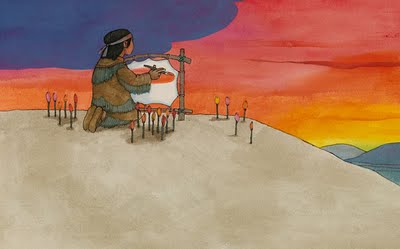
“I see the legend of St. Christopher as a very beautiful legend. St. Christopher was thrown out of the calendar of saints during Pope Paul VI. When that happened I said, ‘Oh, come on, that’s ridiculous.’ It doesn’t matter whether he truly lived or not. The legend has a message to it and it’s a beautiful legend, and I’m going to rewrite it and re-illustrate it. … I’m interested in these saintly figures or Biblical figures or traditional figures that are gentle like this gentle giant [Christopher], like Benedict and Scholastica, who actually lived, and formed Western monasticism. And who knows whether Pascual lived or not. That’s another little legend, a Spanish saint, the patron saint of cooking. And the way these people become saints of whatever they’re doing is sometimes really interesting, kind of childlike, and it’s a good story. There was a great English spiritual writer of the late ‘30s, early ‘40s, her name was Caryll Houselander. I loved her writing very much. She was a very, very deep spiritual writer. She made the statement once that people should publish these wonderful legends and stories about the saints because they read like fairy tales. I said, ‘Oh, that’s a very interesting idea. I think I’m going to try that.’ And it’s part of my growing up. I heard those stories as a child. … And nobody seemed to care whether Christopher really lived or not. I loved it when he was thrown out of the calendar of the saints and several Jewish friends of mine said, ‘Well, I’m not getting rid of my St. Christopher medals.’ Everybody I knew had St. Christopher medals because he was the patron saint of travel.”
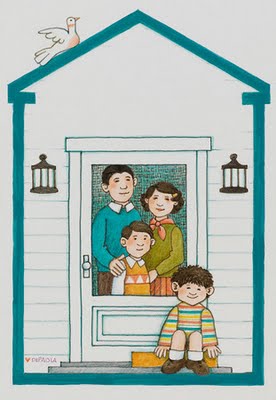
What is it like to be a gay children’s book artist? “It’s probably one of the best fields to be gay in frankly. I found out right from the get-go it made absolutely no difference amongst the editors and the professionals. I imagine there’s some danger if some born-again Christian school out in Midwest finds out. ‘Oh my God, get him out of here.’ But I’ve never had any problems with it. And, of course, there’s so many gay and lesbian people in the field that it’s sort of a moot point. I think it allowed me the opportunity when I was a child not to waste my time batting my head against other people on the football team but to sit and draw. And to take tap dancing lessons and find out about the great world of the stage.”
Which comes up in your book “Oliver Button is a Sissy” (1979): “That book is still in print. But I have to say that personally I’ve never had anything really horrendous happen to me, that I’ve had to ‘face.’ And now I really do think it’s a moot point. Barbara Lucas, who was my editor for ‘Oliver Button,’ I think she was pretty brave to publish it back when it was published. It’s had a long life. And I don’t think it got pulled off shelves as much as the more politically-oriented books like ‘Heather Has Two Mommies.’ Because of the age of the character of the book, sexuality doesn’t play a part in it at all. … It was about being different.”
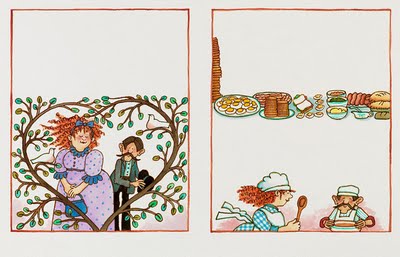
How did you come to the New England tales in “Front Porch Tales & North Country Whoppers” (2007, pictured above)? “I live here. It’s about time that some of these old New England shaggy dog stories are resurrected and put in a collection, at least the beginning of a collection. And, who knows, there may be another volume of those. I moved to New England in 1956. Right out of art school, I entered the monastery. Then left, and came back almost immediately to live in the town of Weston, Vermont, in the middle of the Green Mountains. It was a little mountain village. We were pretty isolated every winter. You’d have to drive all the way over to Bromley and Route 7 to get to Rutland from Weston. We really did have mud season. There was no such thing as paved roads. There were a lot of these wonderful Yankee stories. And a lot of them are getting lost.”
“Since I’ve lived in New London from ’72 I’ve seen a huge change. A lot of the old timers have died off. There are a lot of people moving in from Massachusetts and Connecticut. The kids don’t have farm work to do after school anymore. It’s a totally changed community from what it was when I first moved here. It was a very agricultural community. We do have a nice farm stand. We do have some sort of nice farms. It’s mostly a retirement community for people who have moved to the country for ‘the good life.’ And, of course, what they want is the good life that they used to have in Massachusetts. So I wanted to preserve some of those very funny stories. And I hadn’t seen anybody doing it in a way that I felt I could do it.”
“They’re part of the fabric of the culture, of the place. If I express some of those things that are in ‘Front Porch Tales’: ‘Have you lived here all your life?’ ‘Not yet.’ I’ve never heard that joke from somebody in the Midwest. They have different jokes.”
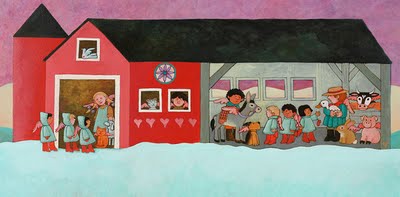
“There’s that story in ‘Front Porch Tales’ of my friend Jack and I being invited to set with Maude and Frank Stevens one Saturday night. And that’s an absolutely true story. We sat there. We didn’t say a word. Maude made fried doughnuts. We sat there. The clock ticked. Finally, Lonnie Fuller said, ‘Well, I’ve got to be going. Really nice settin’ with you, Frank.’ We got in the car and I was like, ‘What the hell was that all about.’ We didn’t say a word. Nobody said a word. And I wasn’t about to because I was the youngest one there. I was 21. And I was an artist. And I had been with those monk fellows for a while. It was like going to the moon. But it was fascinating and it was fun.”
“There were really were these old timers that would sit on the front porch of the country store and just have comments about everything. I really did hear, my own ears, I heard an old farmer on the front porch of a store, when a tourist stopped and said, ‘Excuse me. Do you know the way to Rutland?’ he said, ‘Aiyah.’ And that was his answer.”
What keeps you in New England? “It’s that independence. It’s that hard working. It’s the change of the season. It’s the fact that we still have town meeting here. It’s the urban quality but it doesn’t have this frightening Plains huge expanse of prairie that I find a little disturbing. Whereas people that come from the Plains and come to a small New England town feel hemmed in. I said once to some school children, they said, ‘New Hampshire’s very small on the map.’ I said, ‘Well, no. It maybe looks small on the map, but there are a lot of mountains in New Hampshire and if you ironed it all flat it would be just as big as Minnesota.’”
“Drawings from the Heart: Tomie dePaola Turns 75,” Eric Carle Museum of Picture Book Art, 125 Bay Road, Amherst, Massachusetts, July 3 to Nov. 1, 2009.
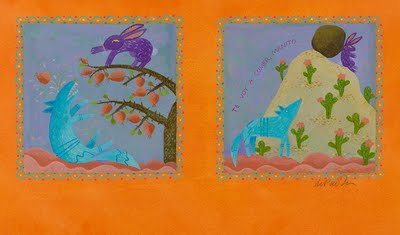
Pictured from top to bottom: Tomie dePaola portrait courtesy of Whitebird Inc.; and illustrations from: “Strega Nona: Her Story” 1996; “Strega Nona” 1975; “Clown of God” 1978 [Harcourt Brace Jovanovich, 1978]; “Adelita” 2002; “Days of the Blackbird” 1997; “Sing, Pierrot, Sing” 1983; “Bill and Pete to the Rescue” 1998; “Legend of Indian Paintbrush” 1988; “26 Fairmount Avenue” 1999; “Front Porch Tales & North Country Whoppers” 2007; “Country Angel Christmas” 1995; “The Tale of Rabbit and Coyote” 1994. All copyright © by Tomie dePaola in the years listed above.






0 Comments:
Post a Comment
<< Home